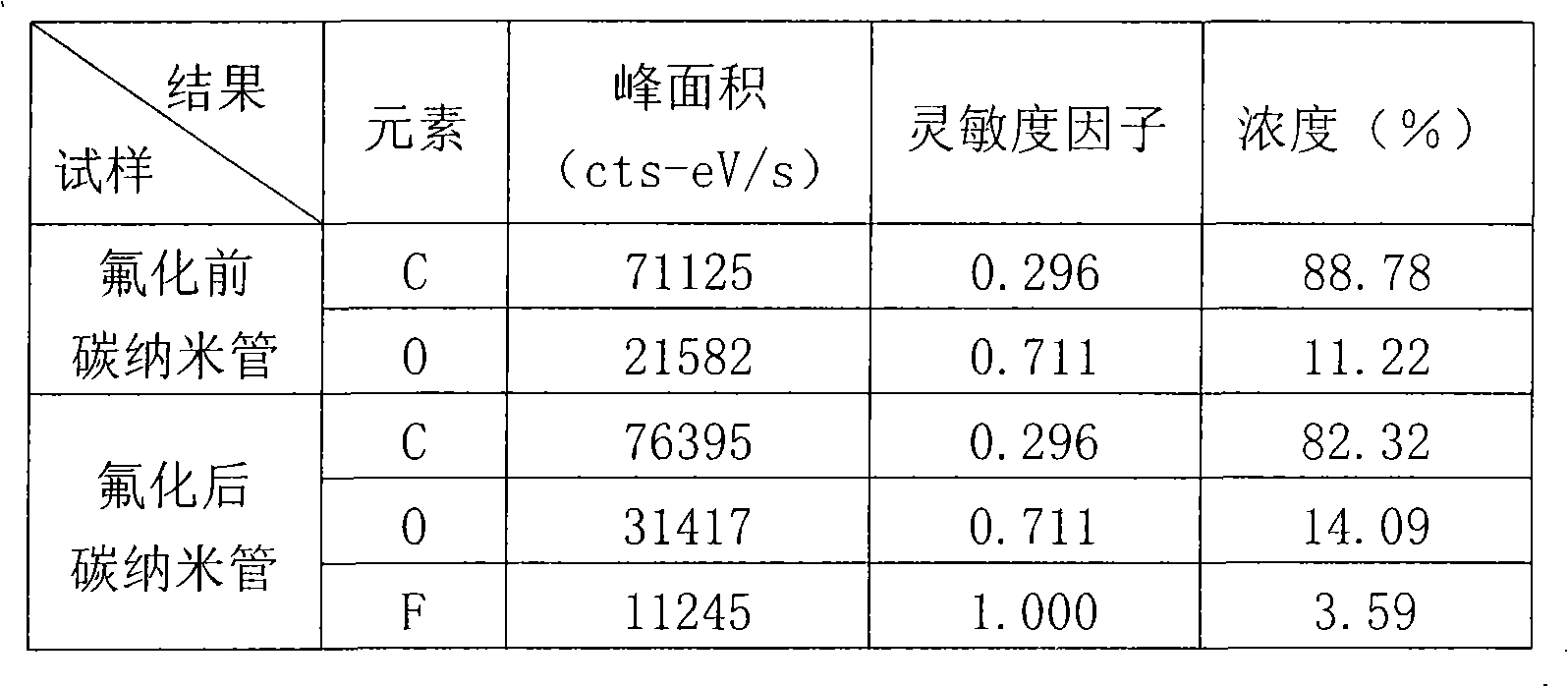Carbon fluoride nanotube and method for making same
A technology of fluorinated carbon nanotubes and carbon nanotubes, which is applied in the direction of nanostructure manufacturing, nanotechnology, nanotechnology, etc., can solve the problems of long reaction time, dangerous operation, complex investment in equipment, etc., and achieve low production cost and safety High and easy-to-obtain raw materials
- Summary
- Abstract
- Description
- Claims
- Application Information
AI Technical Summary
Problems solved by technology
Method used
Image
Examples
Embodiment 1
[0025] First, mix 10 parts of multi-walled carbon nanotubes and 100 parts of polytetrafluoroethylene with a ball mill; put them into a reactor, seal them and put them into a muffle furnace; heat to maintain the reaction temperature at 475±25°C, and react for 1 to 10 Hours later, cool to room temperature, open the reactor, and after grinding, fluorinated carbon nanotubes.
[0026] Multi-walled carbon nanotubes can be directly replaced by an equal share of single-walled carbon nanotubes.
[0027] Polytetrafluoroethylene can be directly replaced by polyperfluoroethylene propylene or polyvinylidene fluoride solid powder in equal proportion.
[0028] The reaction time can be appropriately prolonged by adopting a lower reaction temperature; the reaction time can be appropriately shortened by adopting a higher reaction temperature. As long as the reaction temperature is controlled at 475±25° C. and the reaction time is adjusted accordingly within 1 to 10 hours, carbon nanotubes with...
Embodiment 2
[0030] First, mix 10 parts of multi-walled carbon nanotubes and 200 parts of copolymers of tetrafluoroethylene and perfluoroalkyl vinyl ether evenly with a ball mill; put them into a reactor, seal them and put them into a muffle furnace; heat to maintain the reaction temperature After reacting at 550±50° C. for 1 to 10 hours, cool down to room temperature, open the reactor, and grind to obtain fluorinated carbon nanotubes.
[0031] Multi-walled carbon nanotubes can be directly replaced by an equal share of single-walled carbon nanotubes.
[0032] Tetrafluoroethylene and perfluoroalkyl vinyl ether copolymers can be directly replaced by ethylene and tetrafluoroethylene copolymers in equal proportions.
[0033] The reaction time can be appropriately prolonged by adopting a lower reaction temperature; the reaction time can be appropriately shortened by adopting a higher reaction temperature. As long as the reaction temperature is controlled at 550±50° C. and the reaction time is ...
Embodiment 3
[0035] First, mix 10 parts of multi-walled carbon nanotubes and 300 parts of dodecafluoroheptanol evenly with a colloid mill; put them into a reactor, seal it and put it into a muffle furnace; heat to maintain the reaction temperature at 150±500C, and react for 1~ After 10 hours, cool to room temperature, open the reactor, and grind to obtain fluorinated carbon nanotubes.
[0036] Multi-walled carbon nanotubes can be directly replaced by an equal share of single-walled carbon nanotubes.
[0037] Dodecafluoroheptanol can be directly replaced by an equal share of liquid organic fluorides with higher fluorine content, such as derivatives of dodecafluoroheptanol.
[0038] The reaction time can be appropriately prolonged by adopting a lower reaction temperature; the reaction time can be appropriately shortened by adopting a higher reaction temperature. As long as the reaction temperature is controlled at 150±50° C. and the reaction time is adjusted accordingly within 1 to 10 hours...
PUM
 Login to View More
Login to View More Abstract
Description
Claims
Application Information
 Login to View More
Login to View More - R&D
- Intellectual Property
- Life Sciences
- Materials
- Tech Scout
- Unparalleled Data Quality
- Higher Quality Content
- 60% Fewer Hallucinations
Browse by: Latest US Patents, China's latest patents, Technical Efficacy Thesaurus, Application Domain, Technology Topic, Popular Technical Reports.
© 2025 PatSnap. All rights reserved.Legal|Privacy policy|Modern Slavery Act Transparency Statement|Sitemap|About US| Contact US: help@patsnap.com

